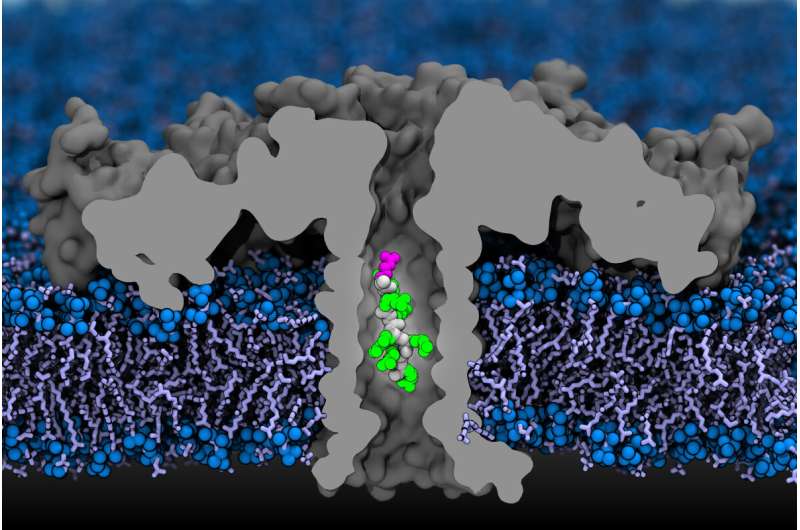Nanopores can identify the amino acids in proteins, the first step to sequencing

While DNA sequencing is a useful tool for determining what's going on in a cell or a person's body, it only tells part of the story. Protein sequencing could soon give researchers a wider window into a cell's workings. A new study demonstrates that nanopores can be used to identify all 20 amino acids in proteins, a major step toward protein sequencing.
Researchers at the University of Illinois at Urbana-Champaign, Cergy-Pontoise University in France and the University of Freiburg in Germany published the findings in the journal Nature Biotechnology.
"DNA codes for many things that can happen; it tells us what is potentially possible. The actual product that comes out—the proteins that do the work in the cell—you can't tell from the DNA alone," said Illinois physics professor Aleksei Aksimentiev, a co-leader of the study. "Many modifications happen along the way during the process of making protein from DNA. The proteins are spliced, chemically modified, folded, and more."
A DNA molecule is itself a template designed for replication, so making copies for sequencing is relatively easy. For proteins, there is no such natural machinery by which to make copies or to read them. Adding to the difficulty, 20 amino acids make up proteins, as compared with the four bases in DNA, and numerous small modifications can be made to each amino acid during protein production and folding.
"Many amino acids are very similar," Aksimentiev said. "For example, if you look at leucine and isoleucine, they have the same atoms, the same molecular weight, and the only difference is that the atoms are connected in a slightly different order."
Nanopores, small protein channels embedded in a membrane, are a popular tool for DNA sequencing. Previously, scientists thought that the differences in amino acids were too small to register with nanopore technology. The new study shows otherwise.
The researchers used a membrane channel naturally made by bacteria, called aerolysin, as their nanopore. In both computer modeling and experimental work, they chopped up proteins and used a chemical carrier to drive the amino acids into the nanopore. The carrier molecule also kept the amino acids inside the pore long enough for it to register a measurable difference in the electrical signature of each amino acid—even leucine and isoleucine, the near-identical twins.
"This work builds confidence and reassures the nanopore community that protein sequencing is indeed possible," said Abdelghani Oukhaled, a professor of biophysics at Cergy-Pontoise whose team carried out much of the experimental work.
The researchers found they could further differentiate modified forms of amino acids by using a more sensitive measurement apparatus or by treating the protein with a chemical to improve differentiation. The measurements are precise enough to potentially identify hundreds of modifications, Aksimentiev said, and even more may be recognized by tweaking the pore.
"This is a proof-of-concept study showing that we can identify the different amino acids," he said. "The current method for protein characterization is mass spectrometry, but that does not determine the sequence; it compares a sample to what's already in the database. Its ability to characterize new variations or mutations is limited. With nanopores, we finally could look at those modifications which have not yet been studied."
The aerolysin nanopore could be integrated into standard nanopore setups, Aksimentiev said, making it accessible to other scientists. The researchers are now exploring approaches to read the amino acids in sequential order as they are cut from the protein. They also are considering other applications for the system.
"One potential application would be to combine this with immunoassays to fish out proteins of interest and then sequence them. Sequencing them will tell us whether they're modified or not, and that could lead to a clinical diagnostic tool," Aksimentiev said.
"This work shows that there's really no limit to how precisely we can characterize biological molecules," he said. "Very likely, one day we will be able to tell the molecular makeup of the cell—what we are made of, down to the level of individual atoms."
More information: Hadjer Ouldali et al, Electrical recognition of the twenty proteinogenic amino acids using an aerolysin nanopore, Nature Biotechnology (2019). DOI: 10.1038/s41587-019-0345-2
Journal information: Nature Biotechnology
Provided by University of Illinois at Urbana-Champaign




















